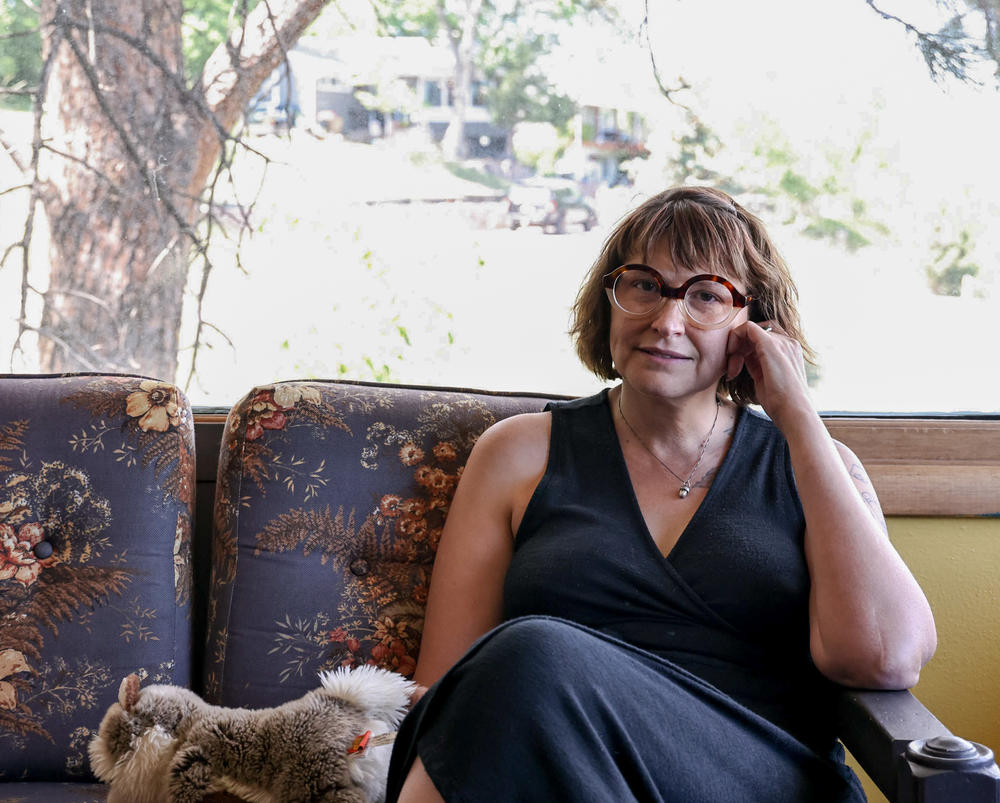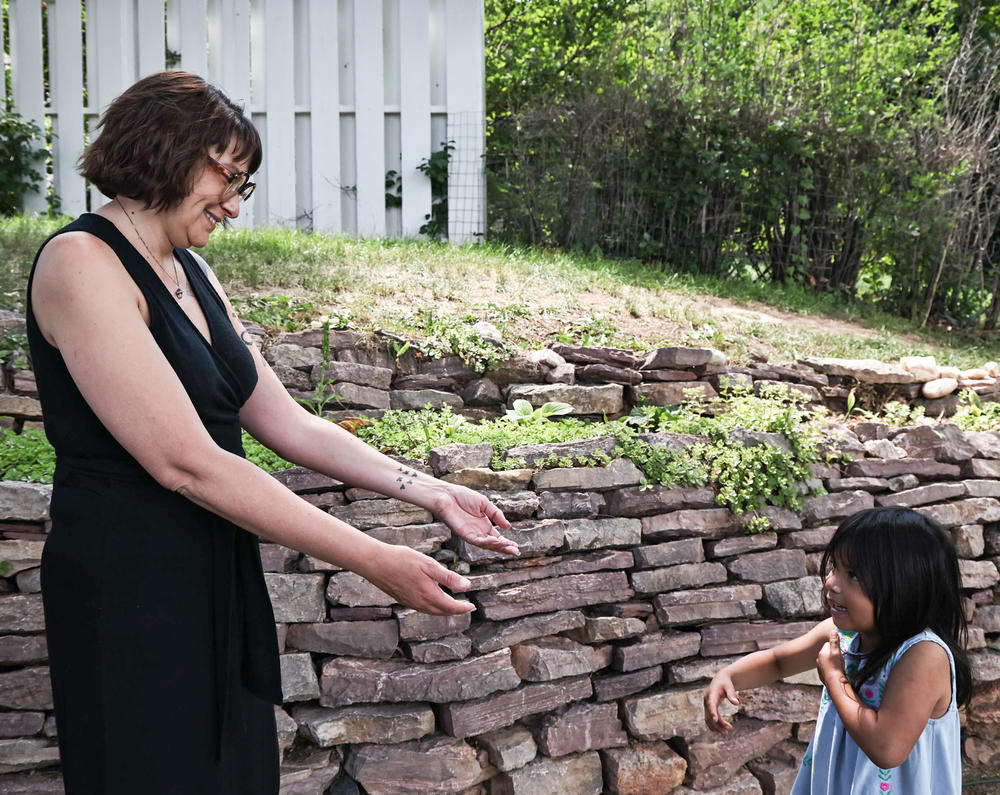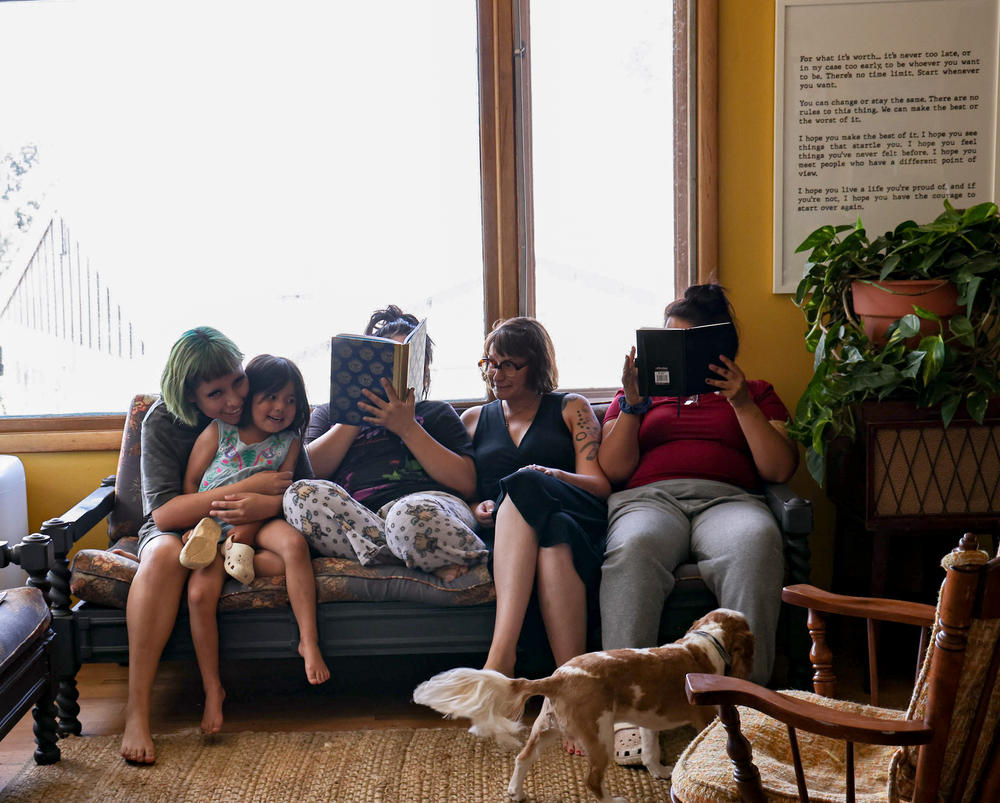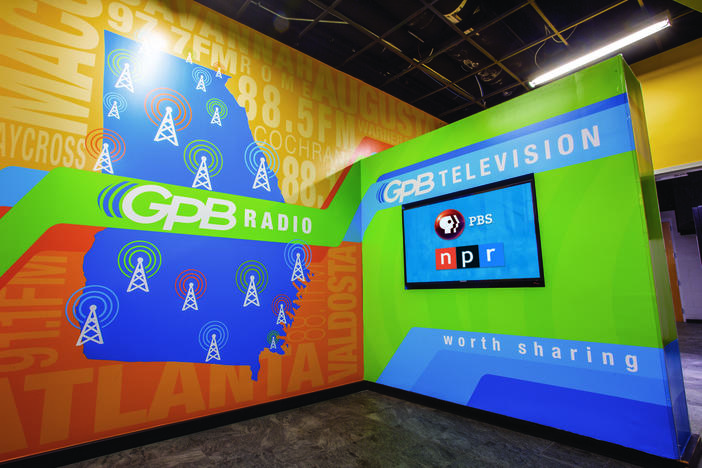Loading...
Section Branding
Header Content
She was already battling cancer. Then she had to fight the bill collectors
Primary Content
RAPID CITY, S.D. ― Jeni Rae Peters would make promises to herself as she lay awake nights after being diagnosed with breast cancer two years ago.
"My kids had lost so much," said Peters, a single mom and mental health counselor. She had just adopted two girls and was fostering four other children. "I swore I wouldn't force them to have yet another parent."
Multiple surgeries, radiation, and chemotherapy controlled the cancer. But, despite having insurance, Peters was left with more than $30,000 of debt, threats from bill collectors, and more anxious nights thinking of her kids.
"Do I pull them out of day care? Do I stop their schooling and tutoring? Do I not help them with college?" Peters asked herself. "My doctor saved my life, but my medical bills are stealing from my children's lives."
Cancer kills about 600,000 people in the U.S. every year, making it a leading cause of death. Many more survive it, because of breakthroughs in medicines and therapies.
But the high costs of modern-day care have left millions with a devastating financial burden. That's forced patients and their families to make gut-wrenching sacrifices even as they confront a grave illness, according to a KHN-NPR investigation of America's sprawling medical debt problem. The project shows few suffer more than those with cancer.
About two-thirds of adults with health care debt who've had cancer themselves or in their family have cut spending on food, clothing, or other household basics, a poll conducted by KFF (Kaiser Family Foundation) for this project found. About 1 in 4 have declared bankruptcy or lost their home to eviction or foreclosure.
Other research shows that patients from minority communities are more likely to experience financial hardships caused by cancer than white patients, reinforcing racial disparities that shadow the U.S. health care system.
"It's crippling," said Dr. Veena Shankaran, a University of Washington oncologist who began studying the financial impact of cancer after seeing patients ruined by medical bills. "Even if someone survives the cancer, they often can't shake the debt."
Shankaran found that cancer patients were 71% more likely than Americans without the disease to have bills in collections, face tax liens and mortgage foreclosure, or experience other financial setbacks. Analyzing bankruptcy records and cancer registries in Washington state, Shankaran and other researchers also discovered that cancer patients were 2½ times more likely to declare bankruptcy than those without the disease.
And cancer patients who went bankrupt were more likely to die than those who did not. Oncologists have a name for this: "financial toxicity," a term that echoes the intractable vomiting, life-threatening infections and other noxious effects of chemotherapy.
"Sometimes," Shankaran said, "it's tough to think about what the system puts patients through."
Cancer diagnosis upends a family
At the three-bedroom home in Rapid City that Peters shares with her children and a friend, there isn't time most days to dwell on these worries. There are ice skating lessons and driving tests and countless meals to prepare. Teenagers drift in and out, chattering about homework and tattoos and driving.
The smallest children congregate at a small kitchen table under a wall decorated with seven old telephones. (As Peters tells it, the red one is a hotline to Santa, a green one to the Grinch, and a space shuttle-shaped phone connects to astronauts orbiting the Earth.)
Peters, 44, presides cheerfully over the chaos, directing her children with snide asides and expressions of love. She watches proudly as one teenage daughter helps another with math in the living room. Later she dances with a 5-year-old to Queen under a disco ball in the entry hall.
Peters, who sports tattoos and earlier this year dyed her hair purple, never planned to have a family. In her late 30s, she wanted to do more for her adopted community, so she took in foster children, many of whom come from the nearby Pine Ridge Indian Reservation. One of her daughters had been homeless.
"Foster kids are amazing humans," she said. "I joke I'm the most reluctant parent of the most amazing children that have ever existed. And I get to help raise these little people to be healthy and safe."
In spring 2020, the secure world Peters had carefully tended was shattered. As the COVID pandemic spread across the country, she was diagnosed with stage 2 breast cancer.
Within weeks, she had an intravenous port inserted into her chest. Surgeons removed both her breasts, then her ovaries after tests showed she was at risk of ovarian cancer, as well.
Cancer treatment today often entails a costly, debilitating march of procedures, infusions, and radiation sessions that can exhaust patients physically and emotionally. It was scary, Peters said. But she rallied her children. "We talked a lot about how they had all lost siblings or parents or other relatives," she said. "All I had to do was lose my boobs."
Much harder, she said, were the endless and perplexing medical bills.
There were bills from the anesthesiologists who attended her surgeries, from the hospital, and from a surgery center. For a while, the hospital stopped sending bills. Then in April, Peters got a call one morning from a bill collector saying she owed $13,000. In total, Peters estimates her medical debts now exceed $30,000.
High costs, despite insurance
Debts of that size Peters carried aren't unusual. Nationwide, about 1 in 5 indebted adults who have had cancer or have a family member who's been sick say they owe $10,000 or more, according to the KFF poll. Those dealing with cancer are also more likely than others with health care debt to owe large sums and to say they don't expect to ever pay them off.
This debt has been fueled in part by the advent of lifesaving therapies that also come with eye-popping price tags. The National Cancer Institute calculated the average cost of medical care and drugs tops $42,000 in the year following a cancer diagnosis. Some treatments can exceed $1 million.
Usually, most costs are covered. But patients are increasingly on the hook for large bills because of annual deductibles and other health plan cost sharing. The average leukemia patient with private health insurance, for example, can expect to pay more than $5,100 in the year after diagnosis, according to an analysis by the consulting firm Milliman.
Even Medicare can leave seniors with huge bills. The average blood cancer patient covered by fee-for-service Medicare can expect to pay more than $17,000 out-of-pocket in the year following diagnosis, Milliman found.
Additionally ongoing surgeries, tests, and medications can make patients pay large out-of-pocket costs year after year. Physicians and patient advocates say this cost sharing ― originally billed as a way to encourage patients to shop for care ― is devastating. "The problem is that model doesn't work very well with cancer," said Dr. David Eagle, an oncologist at New York Cancer & Blood Specialists.
More broadly, the KHN-NPR investigation found that about 100 million people in the U.S. are now in debt from medical or dental bills. Poor health is among the most powerful predictors of debt, with this debt concentrated in parts of the country with the highest levels of illness.
According to the KFF poll, 6 in 10 adults with a chronic disease such as cancer, diabetes, or heart disease or with a close family member who is sick have had some kind of health care debt in the past five years. The poll was designed to capture not just bills patients haven't paid, but also other borrowing used to pay for health care, such as credit cards, payment plans, and loans from friends and family.
For her part, Peters has had seven surgeries since 2020. Through it all, she had health insurance through her employers. Peters said she knew she had to keep working or would lose coverage and face even bigger bills. Like most plans, however, hers have required she pay thousands of dollars out-of-pocket.
Within weeks of her diagnosis, the bills rolled in. Then collectors started calling. One call came as Peters was lying in the recovery room after her double mastectomy. "I was kind of delirious, and I thought it was my kids," she said. "It was someone asking me to pay a medical bill."
Peters faced more bills when she switched jobs later that year and her insurance changed. The deductible and cap on her out-of-pocket costs reset.
In 2021, the deductible and out-of-pocket limit reset again, as they do every year for most health plans. So when Peters slipped on the ice and broke her wrist ― a fracture likely made worse by chemotherapy that weakened her bones ― she was charged thousands more.
This year has brought more surgeries and yet more bills, as her deductible and out-of-pocket limit reset again.
"I don't even know anymore how much I owe," Peters said. "Sometimes it feels like people just send me random bills. I don't even know what they're for."
Making sacrifices to pay the bills
Before getting sick, Peters was earning about $60,000 a year. It was enough to provide for her children, she said, supplemented with a stipend she receives for foster care.
The family budget was always tight. Peters and her kids don't take extravagant vacations. Peters doesn't own her home and has next to no savings. Now, she said, they are living at the edge. "I keep praying there is a shoe fairy," she said, joking about the demands of so many growing feet in her home.
Peters took on extra work to pay some of the bills. Five days a week, she works back-to-back shifts at both a mental health crisis center and a clinic counseling teenagers, some of whom are suicidal. Last year, three friends on the East Coast paid off some of the debt.
But Peters' credit score has tumbled below 600. And the bills pile high on the microwave in her kitchen. "I'm middle-class," she said. "Could I make payments on some of these? Yes, I suppose I could."
That would require trade-offs. She could drop car insurance for her teenage daughter, who just got her license. Canceling ice skating for another daughter would yield an extra $60 a month. But Peters is reluctant.
"Do you know what it feels like to be a foster kid and get a gold medal in ice skating? Do you know what kind of citizen they could become if they know they're special?" she said. "There seems to be a myth that you can pay for it all. You can't."
Many cancer patients face difficult choices.
About 4 in 10 with debt have taken money out of a retirement, college, or other long-term savings account, the KFF poll found; about 3 in 10 have moved in with family or friends or made another change in their living situation.
Dr. Kashyap Patel, chief executive of Carolina Blood and Cancer Care Associates, said the South Carolina practice has found patients turning to food banks and other charities to get by. One patient was living in his car. Patel estimated that half the patients need some kind of financial aid. Even then, many end up in debt.
The Leukemia & Lymphoma Society, which typically helps blood cancer patients navigate health insurance and find food, housing, and other nonmedical assistance, is hearing from more patients simply seeking cash to pay off debt, said Nikki Yuill, who oversees the group's call center.
"People tell us they won't get follow-up care because they can't take on more debt," Yuill said, recalling one man who refused to call an ambulance even though he couldn't get to the hospital. "It breaks your heart."
Academic research has revealed widespread self-rationing by patients. For example, while nearly 1 in 5 people taking oral chemotherapy abandon treatment, about half stop when out-of-pocket costs exceed $2,000, according to a 2017 analysis.
Robin Yabroff, an epidemiologist at the American Cancer Society, said more research must be done to understand the lasting effects of medical debt on cancer survivors and their families. "What does it mean for a family if they have to liquidate savings or drain college funds or sell their home?" Yabroff said. "We just don't know yet."
As Peters put away bags of groceries in her kitchen, she conceded she doesn't know what will happen to her family. Like many patients, she worries about how she'll pay for tests and follow-up care if the cancer reappears.
She is still wading through collection notices in the mail and fielding calls from debt collectors. Peters told one that she was prepared to go to court and ask the judge to decide which of her children should be cut off from after-school activities to pay off the debts.
She asked another debt collector whether he had kids. "He told me that it had been my choice to get the surgery," Peters recalled. "And I said, 'Yeah, I guess I chose not to be dead.' "
The audio version of this story was produced by Seth Tupper at South Dakota Public Broadcasting.
KHN (Kaiser Health News) is a national newsroom that produces in-depth journalism about health issues. It is an editorially independent operating program of KFF (Kaiser Family Foundation).
Copyright 2022 Kaiser Health News. To see more, visit Kaiser Health News.




